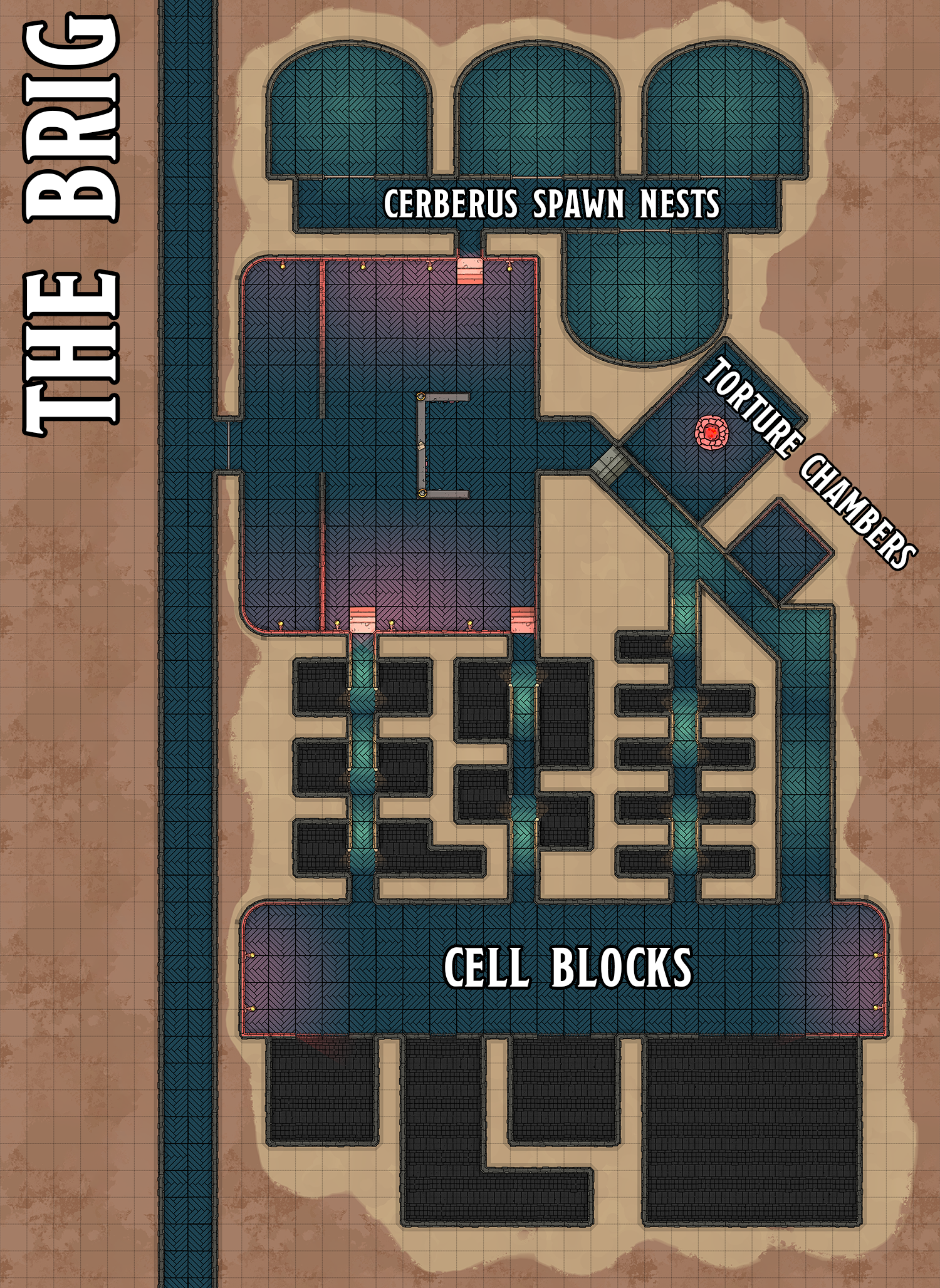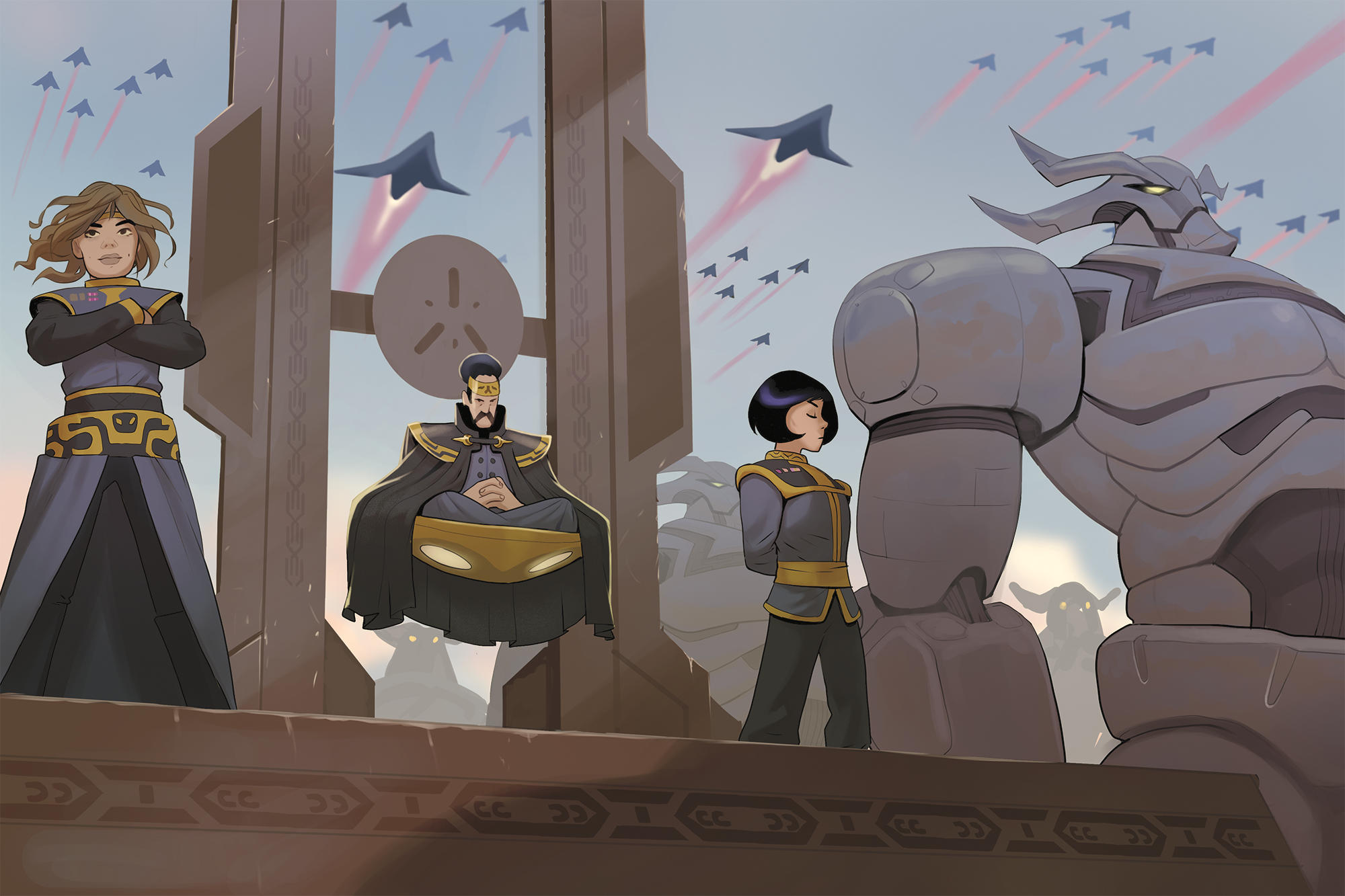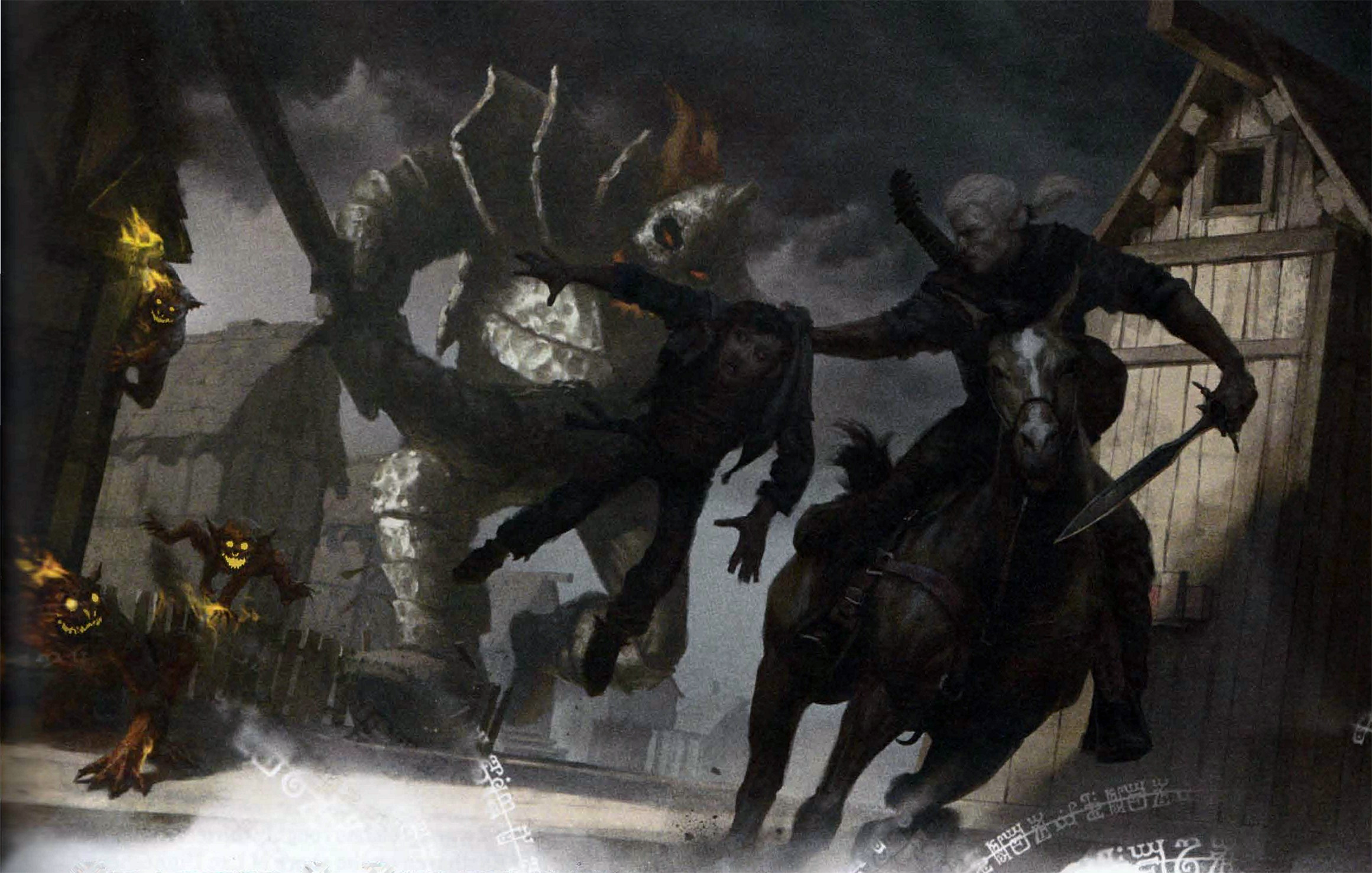This map is designed for use with Part 7D: Raid on the Flying Fortress. You can download a large version without labels for VTT use by clicking the image.
Archive for the ‘Roleplaying Games’ category
Remixing Avernus – Map Pack: Flying Fortress Brig
Magical Kitties Save the Day: Beyond the Hometown
In Magical Kitties Save the Day every kitty has a human and every human has a Problem. The hometown where your human lives is also filled with Problems – witches, time-traveling dinosaurs, hyper-intelligent raccoons, and the like. These hometown Problems make your human’s Problems worse, so you need to solve these Problems with your magical powers and save the day!
The hometowns in Magical Kitties come stocked with hometown Problems, and the players will create their human’s Problems during character creation. The GM can create Magical Kitties adventures by taking a hometown Problem and aiming it at a human Problem.
For example, if your human’s Problem is that they’ve lost their job:
- An evil leprechaun might tempt them with its pot of gold, trying to trick them into making a fairy bargain.
- A hyper-intelligent raccoon might steal their car for their experiments, making it more difficult for them to get to their interviews.
- Their new job offer might come from a corporation that the kitties know to be run by an immortal sorcerer with a nefarious agenda.
The kitty krew is going to have to do something!
While a single hometown can often be just the right size for a Magical Kitties series, you may want to scale things up. Maybe as the kitties start dealing with bigger and bigger problems, the campaign will grow in scope. Or maybe you’ll want to launch a new campaign focused on the GKT (the Galactic Kitty Taskforce).
Fortunately, it’s easy to take things to the next level.
REGIONS
You might want your kitties to have free rein of the state, the country, the planet, or even the whole galaxy. While that might sound like a lot of work, fear not, because a planet is really just a big hometown!
We can refer to these larger areas as regions. Although they’re larger than a hometown, you can create them and run them in the same way: They’ll have region Problems, which work just like hometown Problems. You’ll aim region Problems at human Problems to create adventures, and by going on those adventures the kitties will reduce the rank of the region Problem.
Creating a region works just like creating a hometown: Give it Problems, locations, and a supporting cast. The only difference is that instead of a location being a building or an ancient tree, it might be a whole town or an entire forest. Of course, if a single building in the region is really important, it can still be its own location in the region. The supporting cast in a region also works like any other hometown: These are the humans, animals, aliens, and other mythical creatures that live in the region and inspire adventures. Some might have a greater impact on the region, like the King of the Birds or the lead scientist for a company capturing magical creatures, but others can just be common folk.
THE MANY ARE ONE
As kitties become more powerful and deal with bigger Problems, their new “humans” might not be single individuals. Instead, they might be a group of humans, such as a family, an organization, a town, or even a whole kingdom. These communities still have Problems that the kitties need to solve, but instead of affecting only a single individual, they afflict most or all of the humans in the community.
For example, the entire community of River City might be suffering economically because the Union Chemical Plant shut down. A kingdom has to deal with political strife after the queen passes away with no heir. The android community could be experiencing prejudice from humans who don’t think of them as anything more than machines. Rocket Laboratories could be under a lot of pressure to deliver their new interplanetary shuttles. And so forth.
Despite the scale and scope of these Problems being larger, these community Problems work just like human Problems: They have ranks, you can point hometown Problems or region Problems at them to create adventures, and the ranks of the community Problem will go down (and eventually be eliminated) as the kitty krew successfully completes adventures.
Even though the kitties are now dealing with the Problems of large groups of humans, you’ll want to create a few specific supporting casting members in the group that kitties can directly interact with. These personal relationships will help give meaning to the struggles of the community.
REGIONS WITHIN REGIONS
As you build your series, you may find it useful to think of regions fractally: Regions can contain other regions which contain hometowns. For example, a planet can have many countries; countries can have many districts; a district can have many towns in it.
Just as you can connect multiple hometowns into a single series, you can also connect regions. You can also zoom in and out between regions. For example, you might be running a planet-scale series where the kitties are grappling with Earth-wide Problems. But any time you (or they) might choose to focus on just one town and its hometown Problems (along with its locations and supporting cast) for awhile, before swapping to a different hometown or zooming back out to the planetary scale.
Ask the Alexandrian #6: Revelation For Another Day

G. asks:
A villain in my campaign has run away to fight again another day. The players want to pursue them, but the villain is in hiding. How many clues should I prep for a revelation that I don’t want the PCs to access?
One thing to consider is what you mean by “access.” There are lots of non-actionable revelations you can have about, say, the Lost City of Arthak-Val without ever learning where it is or how to find it; i.e., without being able to access the Lost City. The same can be true about your villain’s hiding spot.
But if by “access” you mean “learn the revelation,” then the answer to how many clues you should prep is zero. The Three Clue Rule isn’t about how many clues the players need to draw a conclusion; it’s about having redundancy for missed or misunderstood clues. A single clue can (and usually should) be enough for the players to figure something out.
Of course, that seems to be the case here: You have a revelation that the players want (“the bad guy has gone to location X”) that you don’t want to give them.
My personal druthers here are going to default to playing to find out: If the players can figure out some plausible way to learn that information, let’s roll with it and see what happens.
What I don’t need to do, though, is go out of my way to provide them with those leads. The Three Clue Rule, it should be remembered, only applies to essential revelations. If the finding the bad guy is not, in my opinion, an essential revelation, then I’m under no obligation to provide three clues or any clues for it. I’m just saying that I won’t automatically block the players if they come up with some clever idea.
When your first impulse is “you can’t find that information,” however, here are a few things to consider.
First, looking for the thing they want doesn’t find what they want (i.e., the bad guy), but it does find something interesting. In other words, reward the players’ efforts, albeit not in the way they were expecting.
Second, consider rephasing your initial impulse from “there’s no way to find the bad guy” to “finding the bad guy will not be trivial.” In this case, “not trivial” means that there isn’t a direct vector from the PCs to the bad guy. Instead, the PCs will have to work their way through several revelations to get to the revelation they want.
For example: You don’t find the bad guy, but you do learn that the only person who might know where the bad guy is hiding is Sebastian Raoul, his lieutenant. Where’s Sebastian? Well, turns out he’s gone to ground, too. Looking for a lead on Sebastian turns up his accountant. It takes a raid on an armored compound to get your hands on him. He doesn’t know where Sebastian is, either, but he knows that Sebastian’s bank accounts are held in a Swiss bank. So if you break into the bank, you might be able to trace where the account is being accessed from. That, finally, leads you to Sebastian, who can give you a lead on the bad guy. (Although possibly still not directly to the bad guy.)
During this whole sequence, of course, the players are engaged and excited. They don’t feel thwarted. They’re constantly making progress towards their goal!
Meanwhile, the rest of the scenario — whatever it might be — is still going on. Each of these steps along the path to finding the bad guy can also be seeded with additional clues and rewards that can assist or direct the PCs towards the other stuff happening in the scenario.
On a similar note, you can also respond to this impulse by immediately dogpiling the PCs with distractions. Toss lots of scenario hooks at them. Pull out a bunch of proactive nodes. Sure, they want to go looking for the bad guy, but there are vampires attacking the orphanage right now, so that’s going to have to wait. (Note: You’re not making that decision for them; you’re just putting them in a situation where they need to choose between a long-term goal of finding the bad guy and responding to immediate crises.)
DESIGNING VECTOR PATHS
The example of extending the path to a revelation may seem really complicated, but this is why I find thinking in terms of vectors so useful.
To unpack this a bit, it can be natural to think in terms of where the PCs are now and ask yourself, “What do they need to do from where they are to get where they want to go?”
If there’s a clear answer to that, great. But if there isn’t, you can give yourself a real headache trying to figure it out. Which makes sense: You’re basically trying to solve an imaginary mystery for which you haven’t created the clues yet.
This can also lend itself to overly simplistic resolutions: “I’m at Point A, how do I get to Point B?” tends to result in a straight line from A to B, which is exactly what we’re not looking for right now.
Instead, start from where they want to go (or what they want to know) and ask yourself, “How do they get there?” and/or “Why is it difficult to get there?” Then take the answer to that question and ask it again.
So:
- How do they find the Bad Guy? Sebastian, his lieutenant, knows.
- How do they find Sebastian? By tracking his banking activity.
- How do they find his banking activity? By accessing his Swiss bank account.
- Why is it difficult to access the Swiss bank? It has to be identified.
- How do they identify the Swiss bank? By getting their hands on Sebastian’s accountant.
- Why is it difficult to get their hands on the accountant? Because he’s holed up in an armed compound.
Then you just flip this around to determine the path.
The one trick, though, is that the PCs need to understand that this IS the path. Otherwise, they’re just blindly fumbling around. (If you tell them “there’s an accountant named Bartolo Russo holed up in an armed compound,” they’ll have no idea why they should care about that.)
To close the loop, PCs can figure out the path through non-actionable revelations: “To find the bad guy, you have to find Sebastian.” That’s a non-actionable because they don’t know where Sebastian is. You could have them do another investigation to figure out where Sebastian is, or you could pack that into the “find Sebastian” revelation (i.e., the revelation is “you’ll have to find Sebastian, and Sebastian’s only known associate is an accountant”).
One last subtlety I used here is to obfuscate an intermediary step when the PCs were figuring out the path they needed to pursue: They know they need the accountant, but they don’t realize that the accountant can’t send them directly to Sebastian (and they’ll need to go through the Swiss bank). This is a good technique because it stops the resolution of the path from being rote (you discovered all the steps, now you do all the steps); and it can also tighten up the “finding the path” phase of things to reduce the perception of “endless brick walls” without any sense of forward progress.
The particular example given here is also quite linear. This can be fine, but you can add some extra dynamics by providing multiple vector options at a particular step. For example, instead of the accountant being Sebastian’s only known associate, you might have three different known associates the PCs could potentially learn about and use to track him down. (Keep in mind that you don’t need to fully prep a path until the PCs actually take it. For example, you don’t need to prep the accountant’s compound until the players tell you that’s where they’re heading in the next session.)
5E Monster: Ash Wraith
Ash wraiths are the undead, burnt remains of corpses. They take the form of a swirling cloud of gray-black ash, usually vaguely humanoid in shape. Although they cannot properly be said to have corporeal bodies, their touch retains the passionate heat of their deaths and is scalding to mortal flesh.
Hauntings. Ash wraiths are most often found haunting ruined crematoriums or lingering near the horrors of execution pyres, but there are also tales of woods being haunted by ash wraith animals for years or even decades after the devastation of forest fires.
From One, Many. Ash wraiths can be created using the animate dead spell, although it requires special knowledge to do so.
Necromancers who perfect the rare art of creating ash wraiths are often able to claim two undead servants from a single corpse. Although the rites which create a skeleton usually consume the flesh of the corpse (if it has not already rotted away), a necromancer can first flense the corpse. The flesh and fat is then burned, providing the ashes for the wraith, while the skeleton is animated separately.
Undead Nature. An ash wraith doesn’t require air, food, drink, or sleep.
ASH WRAITH
Medium undead, neutral evil
Armor Class 12
Hit Points 18 (4d8)
Speed 0 ft., fly 30 ft. (hover)
STR 7 (-2), DEX 14 (+2), CON 11 (+0), INT 6 (-2), WIS 8 (-1), CHA 5 (-3)
Damage Resistances acid, cold, fire, lightning, thunder; bludgeoning, piercing, and slashing from nonmagical weapons
Damage Immunities necrotic, poison
Condition Immunities exhaustion, grappled, poisoned, prone, restrained
Senses darkvision 60 ft., passive Perception 9
Languages understands all languages it knew in life, but can’t speak
Challenge ¼ (50 XP)
Proficiency Bonus +2
Ashen Movement. The ash wraith can move through other creatures’ spaces as if they were difficult terrain.
Undead Embers. If damage reduces the ash wraith to 0 hit points, it must make a Constitution saving throw of DC 5 + the damage taken, unless the damage is radiant or from a critical hit. On a success, the ash wraith will reform in 1d4 hours.
ACTIONS
Fiery Touch. Melee Weapon Attack: +3 to hit, reach 5 ft., one target. Hit: 5 (1d6+2) fire damage.
Design Note: Ash wraiths are designed to provide an incorporeal form of undead that can be used in a fashion similar to skeletons and zombies. (In other words, minor undead that aren’t mind-searingly terrifying.) They were originally created for the original 1974 edition of D&D, and that stat block can be found here.
Storm King’s Thunder: Faction Reference
In Storm King’s Thunder there are several factions active in the Savage Frontier which the PCs will either interact with, join, fight, or all three:
- Emerald Enclave
- Harpers
- Order of the Gauntlet
- Zhentarim
For the DM, however, it’s quite difficult to come to grips with these factions, as references to their current activities and resources are scattered randomly throughout the book with only limited cross-referencing.
So I’ve assembled this reference to make it easier for you to juggle these factions in play. The PCs are looking for a faction? A faction member is fleeing to their nearest safehouse or summoning reinforcements? You’ve got a random encounter with a faction member and you want to drop a lead pointing to a local faction operation?
Now you can just consult the reference below and be good to go.
Note: Although I’ve opportunistically included some references to other sourcebooks, this should not be interpreted as a complete survey of those or any other published sources.
Finding a Faction: If the PCs belong to a faction, are in an unfamiliar area, and would like to try to find a local safehouse or operative they can make a DC 15 Intelligence (Investigation) check. The check can be made at advantage in a major metropolis (e.g., Waterdeep) and should be made at disadvantage if they’re in a tiny community in the middle of nowhere (e.g., Nightstone) unless there’s a known presence described below.
If the check succeeds, they find their faction’s local presence. (If you’re at a loss for what that might be, just pull one of the “Wanderers & Random Encounters” listed for the faction below.)
If the check fails, they either failed to find the local faction presence (if it’s described below or if you determine that there should be a local faction presence) or it means that their faction isn’t active in the area.
EMERALD ENCLAVE
- Goldenfields, a major stronghold of the Enclave. (p. 44)
- Fireshear: Emerald Enclave runs a griffon stable overseen by Dasharra Keldabar. (p. 83)
- Jalanthar: Quinn Nardrosz, the head of the Council of Elders, is an Enclave member. (p. 94)
- Shadowtop Cathedral, a meeting place of the Enclave overseen by the treant Turlang. (p. 107)
- Waterdeep: Klarz, the captain of the Koalinth, owes the Emerald Enclave his life.
Wanderers & Random Encounters
- Aerglas, a moon elf who hasn’t been seen in many years. (p. 51)
- Tharra Shyndle, a druid and friend to the treant Turlang. (p. 51)
- Zindra Winterbow, a scout in the area of Triboar. (p. 57)
- Vordana Jezral, a ranger. (p. 71)
- Saarvin, a ranger and self-proclaimed King of Frozenfar. (p. 71)
- Ghalvin Dragonmoor, native of Goldenfields held prisoner in Grudd Haug. (p. 144)
HARPERS
- Bryn Shander: Beldora is the local Harper agent, disguised as a homeless beggar. She has a sending stone connected to Thwip Ironbottom in Hundelstone. (p. 40 & 249; gives quests on p. 44)
- Hundelstone: Thwip Ironbottom, an inventor, is the local Harper agent. Has a sending stone connected to Beldora in Bryn Shander. (p. 44 & 92)
- Silverymoon: A haven for Harpers, but no details given.
- Triboar: Lord Protector Darathra Shendrel is a Harper agent. (p. 53 & 253)
- Yartar: Harper agents are established here. See Inner Circles.
Everlund
- Moongleam Tower: Harper stronghold. Overseen by Moonlord Davianna Yalrannis. (p. 82)
- Krowen Valharrow, a wizard who lives in Moongleam Tower (p. 44 & 60 & 82).
- Dral Thelev: Harper agent living in Danivarr’s House. (p. 60)
Waterdeep
- Open Lord Laeral Silverhand: A friend to Harpers and will agree to meet with them. (p. 157)
- Lord Zelraun Roaringhorn: A Harper agent. (p. 42)
- Captain Zaldar Floshin, captain of the Kelpie’s Kiss. Hires his ship to the Harpers. The bosun, Ilkara Levari, is a Harper agent. (p. 220)
- See Dragon Heist, p. 37, for additional details.
Wanderers & Random Encounters
- Artus Cimber, a former harper who is the last known owner of the Ring of Winter. (p. 1)
- Endrith Vallivoe, retired caravan merchant and friend to the Harpers. (p. 232)
Inner Circles
- A network of teleportation circles controlled by the Harpers. (p. 117-18)
- Everlund Circle: Located in Moongleam Tower.
- Loudwater Circle: Located in the Smiling Satyr tavern.
- Mirabar Circle: Located in stable house loft attended by Zazspar Bronzefire.
- Neverwinter Circle: Located in the attic of a rowhouse.
- Waterdeep Circle: Located in the City of the Dead.
- Yartar Circle: Located in a dilapidated villa.
ORDER OF THE GAUNTLET
- Sir Baric Nylef (Bryn Shander, p. 44 & 249)
- Sir Lanniver (Neverwinter, p. 44)
- Hawk’s Nest (p. 90) is controlled by the Order and raises hippogriffs.
- Helm’s Hold (p. 90, SCAG p. 85) is ruled by a splinter sect of the Order called the Order of the Gilded Eye.
Waterdeep
- Waterdeep has faction representatives. (unspecified in SKT; Dragon Heist, p. 39)
- Halls of Justice, a temple of Tyr located in the Castle Ward. (DH, p. 39)
- Arilosa Adarbretn, captain of the Coin Toss and financial supporter of the Order. (p. 220)
Wanderers & Random Encounters:
- Lady Hariana Hawkwinter (p. 71)
- Sir Jordeth Tavilson (p. 71)
ZHENTARIM
- Nightstone Team, including Kella Darkhope (p. 25) and Xolkin Alassandar’s agents (p. 27).
- Triboar Travelers, a mercenary group based out of Triboar (p. 54). Led by recruiter Urlam Stockspool.
- Fireshear: Zhentarim mercenaries have been hired to guard griffon stables controlled by the Emerald Enclave (p. 83).
- Loudwater: The high lord, Telbor Zazrek, is a paid puppet. (p. 97)
- Mornbryn’s Shield (p. 99) has been taken over Zhentarim strike team led by Oboth Thornstell.
- Rassalanter: Yondral Horn, innkeeper at the Sleeping Dragon, is on Zhentarim payroll. (p. 104)
Daggerford
- The city has hired a large Zhentarim mercenary force led by Nelkin “the Snail” Danniker (p. 80).
- Zhentarim agents in Daggerford are handing out interest free loans to compete with local moneylenders. (p. 53)
- Zirazylym: An undercover bronze dragon and regular customer at the Happy Cow. (p. 80)
Orlbar
- Bargewright Inn (p. 73), controlled by Zhentarim led by militia-master Chalaska Muruin and innkeeper Nalaskur Thaelond. Also the vampire Arik Stillmarsh.
- Zhentarim fortified tower west of town that was recently abandoned due to a giant attack (p. 80).
Waterdeep
- Sees tensions between Zhentarim and Xanathar’s Thieves’ Guild. (unspecified in SKT; see Dragon Heist)
- Captain Drashk, captain of the Lost Cause. (p. 221)
Trade Routes
- Dawn Pass, the Zhentarim have built a stone gatehouse between Llorkh and Parnast (p. 80).
- The Black Road, a trade route controlled by the Zhentarim (p. 77).
Wanderers & Random Encounters:
- Sorelisa Zandra and Naeremos, bounty hunters (p. 43). Looking for Weevil in order to protect him.
- Shalvus Martholio (p. 46 & 250, gives quests on p. 51). Shalvus works for Nalaskur Thaelond (see Bargewright Inn). He later returns to the Bargewright Inn waiting for a new assignment.
- Frylo Nelgorn and a Zhentarim team are meeting fire giant representatives in the ruined city of Nesmé. (p. 100)
- Nilraun Dhaerlost, a Zhentarim mage captured by Storvald and helping him search for the ring of winter (p. 156).
- Jasper Dimmerchasm, who was sent to negotiate with Zalto and is now held prisoner. (p. 184)
Former Holdings
- Llorkh: Zhentarim previously conquered the town, but abandoned it when the mines dried up (p. 96).
- Newfort: Originally founded by the Zhentarim, but they’ve lost their influence. (p.101)
- Thornhold: Formerly held by the Zhentarim, but now controlled by dwarves. (p. 111)
Other
- Everlund: Zhentarim has a strong presence, but no details are given.
- Mirabar: Zhentarim has strong presence, but no details are given.
- Neverwinter: Zhentarim has strong presence, but no details given.
- Silverymoon: Zhentarim has strong presence, but no details given.
- Yartar: Zhentarim has strong presence in Yartar, but no details given.
Archives
Recent Posts
- Ex-RPGNet Review: The Malady of Kings
- Advanced Gamemastery: How to Run Horror RPGs
- The Vladaam Affair – Part 16E: Slave Trade Handouts
- Ex-RPGNet Review: A Lion in the Ropes
- Ptolus: Running the Campaign – Contract Handouts
Recent Comments
- on Review: Heroes of the Borderlands (D&D Starter Set 2025)
- on Review: Heroes of the Borderlands (D&D Starter Set 2025)
- on Thought of the Day: Elven Teeth
- on In the Shadow of the Spire – Session 48A: A Night in the Necropolis
- on The Art of the Key – Part 4: Adversary Rosters
- on Random GM Tip – Running Background Adventures
- on In the Shadow of the Spire – Session 47C: Home Suite Home
- on The Secret Life of Nodes – Part 5: Naturalistic Node Design
- on Review: The Shattered Obelisk
- on Three Clue Rule















